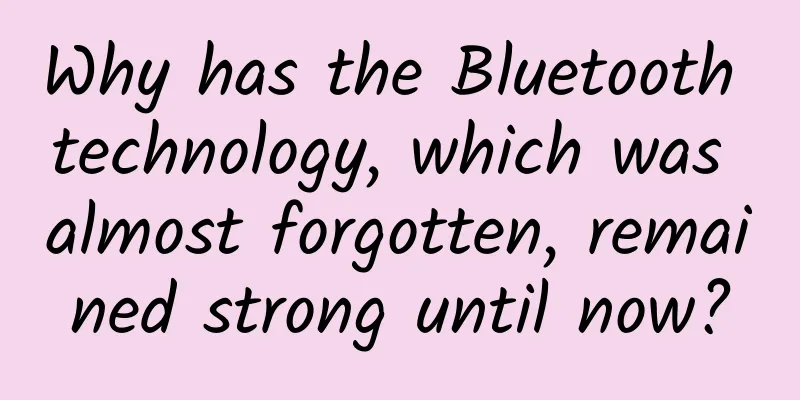Why has the Bluetooth technology, which was almost forgotten, remained strong until now?

|
If you have used the earliest generations of smartphones, you will definitely have a deep impression of the popularity of Bluetooth back then. In that era when there was no WeChat, QQ or 3G version, we transferred files and photos via Bluetooth in just a few seconds. That feeling was really cool. As a result, Bluetooth has gradually become a function that "is basically not used actively, but it is quite uncomfortable if it is not there". After all, in our daily life, Bluetooth headsets and various small smart home and smart wearable devices are based on Bluetooth for information transmission. Why is the Bluetooth technology so strong until now?
Bluetooth is a short-range wireless communication standard first proposed by Ericsson. In 1998, Ericsson, Nokia, IBM, Toshiba and Intel jointly established the predecessor of the Bluetooth Technology Alliance to promote the technology, which made Bluetooth a new favorite of many manufacturers' concept products and terminal devices. As a member of the Bluetooth Technology Alliance, Ericsson launched the world's first Bluetooth mobile phone T36 in 2001, and then Motorola, Samsung and other manufacturers quickly followed suit. As a result, Bluetooth has been popularized in various mobile devices, Bluetooth headsets, Bluetooth gateways, Bluetooth USB interface adapters and other small products. However, the speed of network construction has obviously exceeded everyone's imagination. Broadband has gradually come to the homes of thousands of ordinary people. As of April 2021, fiber-optic broadband users in my country accounted for 94%, gigabit optical networks covered more than 120 million households, and the end-to-end user experience speed of fixed broadband reached 51.2Mbps. This makes the two major technologies represented by Wi-Fi and NFC more well-known than Bluetooth technology, but these two technologies have not "killed Bluetooth". Why is this? As one of the most commonly used functions in daily life, the importance of Wi-Fi is self-evident, and many features of Wi-Fi are similar to Bluetooth. As we are all familiar with, the Wi-Fi direct connection function has been applied by many devices, such as Sony QX series wireless cameras, Sonos speakers, etc., involving printing, games, videos, music, display and other fields. In addition, compared with the 24Mbps transmission rate of Bluetooth, Wi-Fi can achieve a maximum speed of 250Mbps, and is expected to achieve a data transmission speed of 2GB per second in the future, which is one of the advantages that Bluetooth cannot achieve. However, the use of Wi-Fi is very limited, mainly because of its high power consumption, so it is not suitable for wearable, fitness and other devices that require low power transmission. But for home use, such as wireless speakers and video synchronization transmission, Wi-Fi is obviously more advantageous. For devices like smart bracelets, using Bluetooth is the most reliable solution. The popularity of NFC (near field communication technology) has also begun to increase significantly in recent years, which in a sense poses a threat to Bluetooth. It is particularly suitable for point-to-point connection scenarios over short distances, and it also consumes less power. However, its disadvantage is also the distance, which requires a contact of about 4 cm to achieve transmission. Therefore, NFC currently usually plays the role of a "bridge". Android devices often use NFC as a Bluetooth authentication method, allowing users to avoid the tedious pairing and directly achieve Bluetooth connection through contact. Bluetooth has also experienced several standard changes and technology updates in its development from its birth to the present. After entering the 4.0 era, Bluetooth transmission technology has been greatly improved. The most important change is the BLE low-power function, which proposes three modes: low-power Bluetooth, traditional Bluetooth and high-speed Bluetooth. 5.0 has completely opened the door to the Internet of Things era. It has faster and farther transmission capabilities in low-power mode. The transmission rate is twice that of Bluetooth 4.2 (the upper limit is 2Mbps), the effective transmission distance is four times that of Bluetooth 4.2 (theoretically 300 meters), and the data packet capacity is eight times that of Bluetooth 4.2. It supports indoor positioning and navigation functions, and can achieve indoor positioning with an accuracy of less than 1 meter in combination with WiFi. At the same time, it optimizes the underlying IoT Internet of Things, striving to serve smart homes with lower power consumption and higher performance. In the final analysis, whether it is Wi-Fi, NFC, or Zigbee, these technologies are essentially complementary to Bluetooth technology rather than a substitute. With the help of this new trend of smart home, Bluetooth has also seen a new turn. With the development of technology, Bluetooth will become an indispensable technology in the field of smart home. In addition, the Bluetooth Technology Alliance also plans to launch mesh operation enhancements in the near future, allowing mesh to be more widely used in industrial scenarios such as smart lighting and smart buildings. The characteristics of Bluetooth, such as ultra-low power consumption, high speed, long distance, strong anti-interference ability, high network security, and intelligent control function, have enabled it to gain a firm foothold in the era of the Internet of Things. According to research institutions, by 2021, the number of Bluetooth devices in the world is expected to exceed 6 billion. |
<<: 5G commercial use is still not good enough in the past two years? Is 5G really useless?
Recommend
The top five most popular network industry skills in 2018
In the rapidly evolving IT field, professionals a...
Interview with Tong Yongyue: Will CDN that advocates "standard size" have bigger moves in the future?
As the infrastructure of the Internet, CDN has be...
HostYun UK London AS9929 line VPS host 10% discount monthly payment starting from 22.5 yuan, native IP
Those who are interested in UK VPS can pay attent...
Network packet loss troubleshooting solution
1. Location and processing of network packet loss...
China's 4G speed compared to the United States: the gap is amazing
In 2016, the number of China Mobile's 4G user...
How will 5G technology change application development?
Technology is constantly evolving, and it's e...
Faced with the policy requirement of "speeding up and reducing fees", why don't operators respond in this way?
As the Internet becomes more popular, the intelli...
Hengchuang Technology: Hong Kong cloud server starts from 32 yuan/month, buy 2 months of dedicated server and get 1 month free
Hengchuang Technology (henghost.com) has released...
AlphaVPS: €3.5/month-2GB/15G SSD/1TB/5 data centers including Los Angeles and New York
AlphaVPS is a Bulgarian hosting company, founded ...
China Unicom's mixed ownership reform is the trigger for the restructuring of the telecommunications industry order
How will China Mobile and China Telecom respond t...
Musk's satellite internet project may become an unfinished project. Has the US government and military been deceived by him?
Elon Musk, founder of the commercial rocket compa...
[Black Friday] LiteServer: 60% off VPS in the Netherlands, large hard drive VPS/large traffic VPS monthly payment starting from 2.4 euros
LiteServer's Black Friday promotion lasts unt...
Ministry of Industry and Information Technology: We must seize the opportunities of global 5G and industrial Internet
On February 1, the Ministry of Industry and Infor...
Kaspersky Managed Detection and Response Service receives top rating in Garter Peer Insights
Kaspersky’s Kaspersky Managed Detection and Respo...
vivo: From mobile overseas expansion to security protection in the AIGC era
After more than 20 years of development, vivo has...









